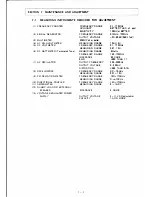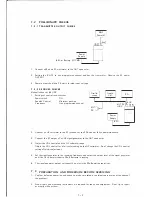
SECT ION
3
C I RCU I T DESC R IPTION
3
-
1
RECE I VE R C I RCUI TS
3
-
1 - 1
A N T E N N A SW I TCHI N G CIRCU I T
Signals from the antenna connector are fed to the antenna switching circuit through Chebyshev low-pass
filter consisting of L229, L230, C295, C297 and C298 in the P L L board.
The antenna switching circuit employs a quater wave switching circuit.
In the receive mode, switching diodes, 0 216 and 0 217 are turned O F F, and they make isolation against
the transmitter circuit and matching circuit, and the incoming signals are fed to the R F amplifier.
3
-
1
-
2 RF AMP L IFI E R A N D F I R ST MIXER
The signals from the switching circuit are fed to the cascade amplifier 0101 and 0102.
The amplified signals are fed to the gate of the first mixer 0103 through the band-pass filter L 102
�
L 104, which reduces interference and intermodulation from out of the band signals.
To the source of 0103, a 145 MHz* signal is supplied from the P L L circuit to convert the RF signals into
1 0.695MHz first IF signals. (*This frequency differs depending on the version, and it can be calculated
by formula; Receive frequency -10.695 MHz.)
The first IF signals are taken from the drain of 0103 and fed to the IF circuit.
3
-
1
-
3 IF C I R CU I T
The first IF signals from 0103 are fed to the matched pair crystal filter F1101, then IF amplifiers 0104
and 0105.
The amplified signals are fed to IC101. IC101 is composed of the second local oscil lator, second mixer,
l imiter amplifier, quadrature detector and active filter circuits.
The second I ocal oscillator oscil I ates 10.240MHz with X 101, and is fed to the second mixer with the first
IF signals to con ve rt into 455KH z second IF signals. The second IF signals are put out from Pin 3, and
fed to external ceramic filter F l 102 which has excellent selectivity, then fed to IC101 (Pin 5) again to
amp Ii fy and detect.
The detected A F signals are put out from Pin 9.
3
-
1
- 4
AF A N D SQUE LCH C I RCUITS
The detected AF signals are put 6dB/Octave de-emphasis by integral circuit consisting of R 117 and C126,
and fed to A F power amplifier IC102 through the VO L U M E control R1, to obtain enough power to
drive the speaker.
Noise components put out from Pin 9 of IC101 are fed to IC101 (Pin 10) again through the SQ U E LCH
con trol R2, which controls the squelch threshold level, filtered about 20KHz signal (noise) and put out
from Pin 11.
This signal (noise) is rectified by 0113, integrated by R135, R136 and C136, and turns 0114 ON and
turns O F F the regulato r for AF power amplifier consisting of 0103, 0115 and 0116.
This reduces the current drain of the set, in the standby condition. When a signal is received, noise is
suppressed by the signal and turns 0114 O F F and the regulator is turned ON and supplies regulated
voltage to the A F power amplifier, and in con:iing signal can be heard from the speaker.
In the transmit mode, a voltage is applied to 0 114 and turns it ON, and turns the regulator O F F the
same as in the standby condition.
3 - 1







































